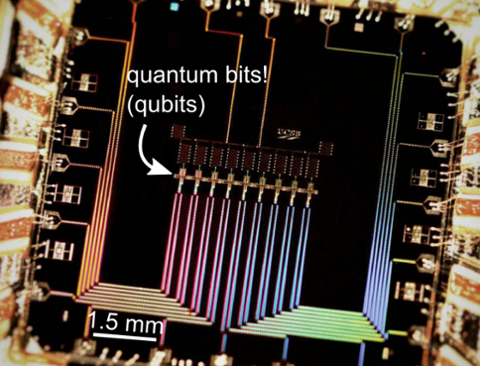 Quantum computing is a subject that will potentially melt your brain. It’s incredibly complicated, and yet it could potentially change how every tech pro on the planet does their job. At its Ignite conference this week, Microsoft announced a quantum-computing programming language woven into Visual Studio, its integrated development environment (IDE). In addition, the company will throw in a “quantum computing simulator” that will allow developers to test programs that leverage quantum-computing algorithms. Anyone who works in tech knows that “conventional” computers deal in binary bits (one or zero; true or false). These bits are also known as “definite states.” Quantum computers, on the other hand, traffic in so-called “qubits,” which can exist not only as zeroes and ones, but also in an in-between state known as a “superposition.” What does that mean? While conventional processors work toward one solution at a time (very quickly, depending on the hardware), a quantum computer can use qubits to explore every potential solution simultaneously. At least on paper, that means a quantum computer can rip through complicated problems (such as decryption) much faster than a conventional one. Quantum computing is very much a work in progress; there’s been a years-long quest, for example, to verify that quantum computers are actually producing the correct answers. “One of the primary challenges is that quantum memory elements (“qubits”) have always been too prone to errors,” Google wrote in a 2015 blog posting on quantum computing. “They’re fragile and easily disturbed—any fluctuation or noise from their environment can introduce memory errors, rendering the computations useless.” Microsoft isn’t the first company to dangle the possibility of quantum computing for the masses. Last year, IBM offered “students, researchers, and general science enthusiasts” with a great idea the chance to use its quantum-computing platform to “run algorithms and experiments, worth with quantum bits (qubits), and explore tutorials and simulations.” Access to the platform hinged on filling out a request form. Although there’s always the possibility that Microsoft’s move to “democratize” quantum computing could change how tech pros approach the technology, the fact remains that quantum-computing hardware is still in its infancy, largely restricted to specialized shops such as IBM, Google, and the NSA. Chances are good that your first experience with quantum computing will come via the cloud—and Microsoft clearly wants its Azure platform to eventually become the conduit for clients’ quantum-computing needs. According to Microsoft, its quantum platform will be available as a free preview by the end of 2017, and include libraries and tutorials; you can sign up for it here. The quantum simulator will simulate problems “that require up to 30 logical qubits of power on [developers’] personal computers,” according to the company’s blog posting on the matter, while customers using the simulator via the Azure cloud can simulate “40 qubits of computational power.”
Quantum computing is a subject that will potentially melt your brain. It’s incredibly complicated, and yet it could potentially change how every tech pro on the planet does their job. At its Ignite conference this week, Microsoft announced a quantum-computing programming language woven into Visual Studio, its integrated development environment (IDE). In addition, the company will throw in a “quantum computing simulator” that will allow developers to test programs that leverage quantum-computing algorithms. Anyone who works in tech knows that “conventional” computers deal in binary bits (one or zero; true or false). These bits are also known as “definite states.” Quantum computers, on the other hand, traffic in so-called “qubits,” which can exist not only as zeroes and ones, but also in an in-between state known as a “superposition.” What does that mean? While conventional processors work toward one solution at a time (very quickly, depending on the hardware), a quantum computer can use qubits to explore every potential solution simultaneously. At least on paper, that means a quantum computer can rip through complicated problems (such as decryption) much faster than a conventional one. Quantum computing is very much a work in progress; there’s been a years-long quest, for example, to verify that quantum computers are actually producing the correct answers. “One of the primary challenges is that quantum memory elements (“qubits”) have always been too prone to errors,” Google wrote in a 2015 blog posting on quantum computing. “They’re fragile and easily disturbed—any fluctuation or noise from their environment can introduce memory errors, rendering the computations useless.” Microsoft isn’t the first company to dangle the possibility of quantum computing for the masses. Last year, IBM offered “students, researchers, and general science enthusiasts” with a great idea the chance to use its quantum-computing platform to “run algorithms and experiments, worth with quantum bits (qubits), and explore tutorials and simulations.” Access to the platform hinged on filling out a request form. Although there’s always the possibility that Microsoft’s move to “democratize” quantum computing could change how tech pros approach the technology, the fact remains that quantum-computing hardware is still in its infancy, largely restricted to specialized shops such as IBM, Google, and the NSA. Chances are good that your first experience with quantum computing will come via the cloud—and Microsoft clearly wants its Azure platform to eventually become the conduit for clients’ quantum-computing needs. According to Microsoft, its quantum platform will be available as a free preview by the end of 2017, and include libraries and tutorials; you can sign up for it here. The quantum simulator will simulate problems “that require up to 30 logical qubits of power on [developers’] personal computers,” according to the company’s blog posting on the matter, while customers using the simulator via the Azure cloud can simulate “40 qubits of computational power.” Microsoft Has Big Plans for Quantum Computing
 Quantum computing is a subject that will potentially melt your brain. It’s incredibly complicated, and yet it could potentially change how every tech pro on the planet does their job. At its Ignite conference this week, Microsoft announced a quantum-computing programming language woven into Visual Studio, its integrated development environment (IDE). In addition, the company will throw in a “quantum computing simulator” that will allow developers to test programs that leverage quantum-computing algorithms. Anyone who works in tech knows that “conventional” computers deal in binary bits (one or zero; true or false). These bits are also known as “definite states.” Quantum computers, on the other hand, traffic in so-called “qubits,” which can exist not only as zeroes and ones, but also in an in-between state known as a “superposition.” What does that mean? While conventional processors work toward one solution at a time (very quickly, depending on the hardware), a quantum computer can use qubits to explore every potential solution simultaneously. At least on paper, that means a quantum computer can rip through complicated problems (such as decryption) much faster than a conventional one. Quantum computing is very much a work in progress; there’s been a years-long quest, for example, to verify that quantum computers are actually producing the correct answers. “One of the primary challenges is that quantum memory elements (“qubits”) have always been too prone to errors,” Google wrote in a 2015 blog posting on quantum computing. “They’re fragile and easily disturbed—any fluctuation or noise from their environment can introduce memory errors, rendering the computations useless.” Microsoft isn’t the first company to dangle the possibility of quantum computing for the masses. Last year, IBM offered “students, researchers, and general science enthusiasts” with a great idea the chance to use its quantum-computing platform to “run algorithms and experiments, worth with quantum bits (qubits), and explore tutorials and simulations.” Access to the platform hinged on filling out a request form. Although there’s always the possibility that Microsoft’s move to “democratize” quantum computing could change how tech pros approach the technology, the fact remains that quantum-computing hardware is still in its infancy, largely restricted to specialized shops such as IBM, Google, and the NSA. Chances are good that your first experience with quantum computing will come via the cloud—and Microsoft clearly wants its Azure platform to eventually become the conduit for clients’ quantum-computing needs. According to Microsoft, its quantum platform will be available as a free preview by the end of 2017, and include libraries and tutorials; you can sign up for it here. The quantum simulator will simulate problems “that require up to 30 logical qubits of power on [developers’] personal computers,” according to the company’s blog posting on the matter, while customers using the simulator via the Azure cloud can simulate “40 qubits of computational power.”
Quantum computing is a subject that will potentially melt your brain. It’s incredibly complicated, and yet it could potentially change how every tech pro on the planet does their job. At its Ignite conference this week, Microsoft announced a quantum-computing programming language woven into Visual Studio, its integrated development environment (IDE). In addition, the company will throw in a “quantum computing simulator” that will allow developers to test programs that leverage quantum-computing algorithms. Anyone who works in tech knows that “conventional” computers deal in binary bits (one or zero; true or false). These bits are also known as “definite states.” Quantum computers, on the other hand, traffic in so-called “qubits,” which can exist not only as zeroes and ones, but also in an in-between state known as a “superposition.” What does that mean? While conventional processors work toward one solution at a time (very quickly, depending on the hardware), a quantum computer can use qubits to explore every potential solution simultaneously. At least on paper, that means a quantum computer can rip through complicated problems (such as decryption) much faster than a conventional one. Quantum computing is very much a work in progress; there’s been a years-long quest, for example, to verify that quantum computers are actually producing the correct answers. “One of the primary challenges is that quantum memory elements (“qubits”) have always been too prone to errors,” Google wrote in a 2015 blog posting on quantum computing. “They’re fragile and easily disturbed—any fluctuation or noise from their environment can introduce memory errors, rendering the computations useless.” Microsoft isn’t the first company to dangle the possibility of quantum computing for the masses. Last year, IBM offered “students, researchers, and general science enthusiasts” with a great idea the chance to use its quantum-computing platform to “run algorithms and experiments, worth with quantum bits (qubits), and explore tutorials and simulations.” Access to the platform hinged on filling out a request form. Although there’s always the possibility that Microsoft’s move to “democratize” quantum computing could change how tech pros approach the technology, the fact remains that quantum-computing hardware is still in its infancy, largely restricted to specialized shops such as IBM, Google, and the NSA. Chances are good that your first experience with quantum computing will come via the cloud—and Microsoft clearly wants its Azure platform to eventually become the conduit for clients’ quantum-computing needs. According to Microsoft, its quantum platform will be available as a free preview by the end of 2017, and include libraries and tutorials; you can sign up for it here. The quantum simulator will simulate problems “that require up to 30 logical qubits of power on [developers’] personal computers,” according to the company’s blog posting on the matter, while customers using the simulator via the Azure cloud can simulate “40 qubits of computational power.” 

